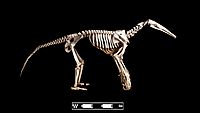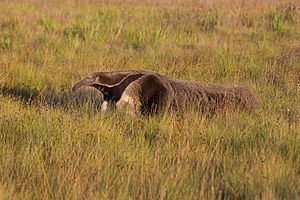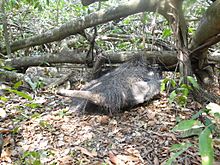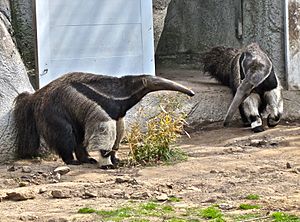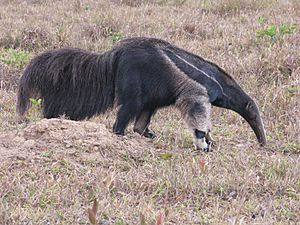Giant anteater facts for kids
Quick facts for kids Giant anteater |
|
|---|---|
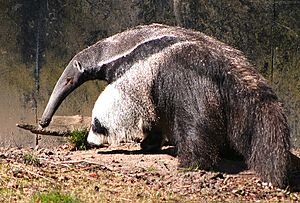 |
|
| A specimen at Copenhagen Zoo, Denmark, 2005 | |
| Conservation status | |
| Scientific classification | |
| Genus: |
Myrmecophaga
|
| Species: |
tridactyla
|
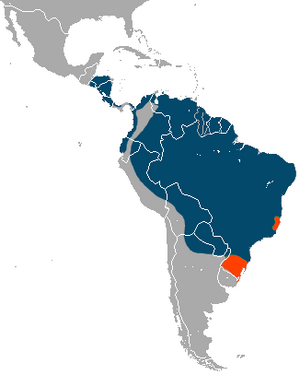 |
|
| Range
extant possibly extinct |
|
| Synonyms | |
|
|
The giant anteater, Myrmecophaga, is an animal that lives in Central and South America. It is also known as the ant bear.
It the only mammal without teeth. Its diet consists of termites and ants, hence the name. It is the largest anteater: its length is between 182 cm and 217 cm. Males weigh between 33 and 41 kg, female are 27 and 39 kg. This species lives on the ground, in contrast to other living anteaters and sloths which are arboreal or semi-arboreal. It forages in open areas and rests in more forested habitats.
Contents
Characteristics
The giant anteater can be identified by its large size, long, narrow muzzle, and long bushy tail. It has a total body length of 182 to 217 cm (5 ft 11+1⁄2 in to 7 ft 1+1⁄2 in). Males weigh 33 to 50 kg (73 to 110 lb) and females weigh 27 to 47 kg (60 to 104 lb), making the giant anteater the biggest extant species in its suborder. The head of the giant anteater, at 30 cm (12 in) long, is particularly elongated, even when compared to other anteaters. Its cylindrical snout takes up most of its head. Its eyes, ears and mouth are relatively small. It has poor eyesight, but has a powerful sense of smell; 40 times that of a human. While there is some difference in size and shape between the sexes, males being larger and more robust, telling them apart from a distance can be difficult.
Even for an anteater, the neck is especially thick compared to the back of the head, and a small hump protrudes behind the neck. The coat is mostly greyish, brown or black with mottled white. They have white front legs with black ringed wrists and hands, and dark hind legs. From the throat to the shoulders is a thick black mark with white outlines and sharp tips. The body ends in a brown tail. The coat hairs are long, especially on the tail, which makes the appendage look larger than it actually is. An erect mane stretches along the back. The bold pattern was thought to be disruptive camouflage, but a 2009 study suggests it is warning coloration.
The giant anteater has broad ribs. It has five toes on each foot. Three toes on the front feet have claws, which are particularly large on the third digits. It walks on its front knuckles similar to gorillas and chimpanzees. This allows the giant anteater to walk without scraping its claws on the ground. The middle digits, which support most of its weight, have long metacarpophalangeal joints and bent interphalangeal joints. Unlike the front feet, the hind feet have short claws on all five toes and walk plantigrade. As a "hook-and-pull" digger, the giant anteater has a large supraspinous fossa which gives the teres major more leverage—increasing the front limbs' pulling power—and the triceps muscle helps control the thickened middle digit.
The giant anteater has a low body temperature for a mammal, about 33 °C (91 °F), a few degrees lower than a typical mammalian temperature of 36 to 38 °C (97 to 100 °F). Xenarthrans in general tend to have lower metabolic rates than most other mammals, a trend thought to correlate with their dietary specializations and low mobility.
Feeding anatomy
The giant anteater has no teeth and is capable of very limited jaw movement. It relies on the rotation of the two halves of its lower jaw, held together by a ligament connecting the rami, to open and close its mouth. This is accomplished by its chewing muscles, which are relatively underdeveloped. Jaw depression creates an oral opening large enough for the slender tongue to flick out. It has a length of around 60 cm (24 in) and is more triangular in the back but becomes more rounded towards the front and ends in a rounded tip. The tongue has backward-curving papillae and is extremely moist due to the large salivary glands.
The tongue can only move forwards and backwards due to the tiny mouth and shape of the snout. During feeding, the animal relies on the direction of its head for aim. When fully extended, the tongue reaches 45 cm (18 in), and can move in and out around 160 times per minute (nearly three times per second). A unique sternoglossus muscle, a combination of the sternohyoid and the hyoglossus, anchors the tongue directly to the sternum. The hyoid apparatus is large, V-shaped and flexible, and supports the tongue as it moves. The buccinator muscles loosen and tighten, allowing food in and preventing it from falling out. When retracted, the tongue is held in the oropharynx, preventing it from blocking respiration.
The anteater rubs its tongue against its palate to smash the insects for swallowing. Unlike other mammals, giant anteaters swallow almost constantly when feeding. The giant anteater's stomach, similar to a bird's gizzard, has hardened folds to crush food, assisted by some sand and soil. The giant anteater cannot produce stomach acid of its own, but digests using the formic acid of its prey.
Distribution and status
The giant anteater is native to Central and South America; its known range stretches from Honduras to Bolivia and northern Argentina, and fossil remains have been found as far north as northwestern Sonora, Mexico. It is largely absent from the Andes and has been fully extirpated in Uruguay, Belize, El Salvador, and Guatemala, as well as in parts of Costa Rica, Brazil, Argentina, and Paraguay. The species can live in both tropical rainforests and arid shrublands, provided enough prey is present to sustain it.
The species is listed as vulnerable by the International Union for Conservation of Nature, due to the number of regional extirpations, and under Appendix II by CITES, tightly restricting international trade in specimens. By 2014, the total population declined more than 30 percent "over the last three generations". In 1994, some 340 giant anteaters died due to wildfires at Emas National Park in Brazil. The animal is particularly vulnerable to fires as its coat can easily catch ablaze and it is too slow to escape.
Human-induced threats include collision with vehicles, attacks by dogs and destruction of habitat. One study of anteater mortality along roads found that they are likely to be struck on linear roads near native plants. A 2018 study in Brazil found that: (1) roads were more likely to be detrimental to anteaters because of habitat fragmentation rather than vehicle accidents, (2) 18–20% of satisfactory anteater habitat did not reach minimum patch size (3) 0.1–1% of its range had dangerously high road density, (4) 32–36% of the anteater's distribution represented critical areas for its survival and (5) more conservation opportunities existed in the north of the country. A 2020 study in the Brazilian cerrado found that road mortality can cut population growth by 50 percent at the local level.
The giant anteater is commonly hunted in Bolivia, both as a trophy and food. The animal's thick, leathery hide is used to make horse-riding equipment in the Chaco. In Venezuela, it is slain for its claws. Giant anteaters are also killed for their perceived danger, particularly during threat displays. The biggest ecological strengths of the species is its wide range and adaptability. The Amazon, Pantanal and the cerrado have various protected areas were the anteater finds refuge. In Argentina, some local governments list it as national heritage species, affording it official protection.
Behaviour and ecology
Despite its iconic status, the giant anteater is little studied in the wild and research has been limited to certain areas. The species may use multiple habitats. A 2007 study of giant anteaters in the Brazilian Pantanal found that the animals move and forage in open areas and rest in forest; the latter provide shade when the temperature rises and retain heat when the temperature drops. Anteaters may travel an average of 3,700 m (12,100 ft) per day. Giant anteaters can be either diurnal or nocturnal. A 2006 study in the Pantanal found them to be mostly nocturnal when it is warm, but became more active in daylight hours as the temperature dropped. Diurnal giant anteaters have been observed at Serra da Canastra. Nocturnality in anteaters may be a response to human disturbances.
Giant anteaters prefer dense brush to sleep in, but when it gets cooler, they may use tall grass. When they need to rest, they carve a shallow cavity in the ground. The animal sleeps curled up with its bushy tail over its body; both to keep it warm and camouflage it from predators. One anteater was recorded sleeping flat on its side with the tail unfolded on a 17 °C (63 °F) morning; possibly to allow its body to absorb the sun's rays for warmth. Giant anteaters sometimes enter water to bathe and even swim across wide rivers. They are also able to climb and have been recorded ascending both termite mounds and trees while foraging. One individual was observed attempting to climb a tree by rearing up and grabbing onto a branch above it.
Spacing
Giant anteater home ranges vary in size depending on the location, ranging as small as 2.7 km2 (667 acres) in Serra da Canastra National Park, Brazil, to as large as 32.5 km2 (8,031 acres) in Iberá Natural Reserve, Argentina. Individuals mostly live alone, aside from young who stay with their mothers. Anteaters keep in contact with secretions from their anal glands and tree markings. They appear to be able to recognize each other's saliva by scent.
Females are more tolerant of each other than males are, and thus are more likely to be found closer together. Males are more likely to engage in agonistic behaviors, which start with the combatants approaching and circling each other while uttering a "harrr" noise. This can escalate into chasing and actual fighting. Combat includes wrestling and slashing with the claws. Fighting anteaters may emit roars or bellows. Males are possibly territorial.
Foraging
This animal is an insectivore, feeding mostly on ants or termites. In areas that experience regular flooding, like the Pantanal and the Venezuelan-Colombian Llanos, anteaters mainly feed on ants because termites are less available. Conversely, anteaters at Emas National Park eat mainly termites, which are numerous in the grassland habitat. At Serra da Canastra, during the wet season (October to March) anteaters eat mainly ants, while during the dry season (May to September) they switch to termites.
Anteaters track prey by their scent. After finding a nest, the animal tears it open with its claws and inserts its long, sticky tongue to collect its prey (which includes eggs, larvae and adult insects). An anteater attacks up to 200 nests in one day, for as long as a minute each, and consumes a total of around 35,000 insects. The anteater may be driven away from a nest by the chemical or biting attacks of soldiers. Termites may rely on their fortified mounds for protection or use underground or wide spreading tunnels to escape.
Other prey include the larvae of beetles and western honey bees. Anteaters may target termite mounds with bee hives. Captive anteaters are fed mixtures of milk and eggs as well as mealworms and ground beef. To drink, an anteater may dig for water when none at the surface is available, creating waterholes for other animals.
Reproduction and parenting
Giant anteaters mate all year. A male trails an estrous female, who partially raises her tail. Courting pairs are known to share the same insect nest during feeding. Mating involves the female laying sideways and the male hunching over. A couple may stay together for up to three days and mate multiple times during that period. Giant anteater have a 170–190 day gestation period which ends with the birth of a single pup. There is some evidence that the species can experience delayed implantation. Females give birth standing upright.
Pups are born weighing 1–2 kg (2.2–4.4 lb) with eyes closed for the first six days. The mother carries its dependent young on its back. The pup camouflages against its mother by aligning its black and white band with hers. The mother grooms and nurses her young, which communicates with her using sharp whistles. After three months, grooming declines and the young starts to eat more solid food. Both grooming and nursing bouts end at 10 months, which is also when the young leaves its mother. They are sexually mature in 2.5–4 years.
Mortality
Giant anteaters may live around 15 years in the wild, but can live twice that in captivity. They are preyed on by jaguars and pumas and typically flee from danger by galloping, but if cornered, will rear up on their hind legs and attack with the claws. The front claws of the giant anteater are formidable weapons, capable of potentially killing a jaguar. The giant anteater is a host of the Acanthocephalan intestinal parasites Gigantorhynchus echinodiscus and Moniliformis monoechinus.
Interactions with humans
Although they are usually not a threat to humans, giant anteaters can inflict severe wounds with their front claws. Between 2010 and 2012, two hunters were killed by giant anteaters in Brazil; in both cases, the attacks appeared to be defensive behaviors.
Related pages
Images for kids
-
Anteater mask and scratcher used by Kayapo boys in their ceremonies
See also
 In Spanish: Myrmecophaga tridactyla para niños
In Spanish: Myrmecophaga tridactyla para niños




